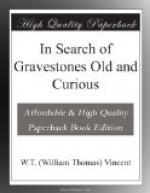Fig. 58.—At Frindsbury.
The inscription is effaced, but the
date appears
to be 1751.
The overturned sheaf presumably refers metaphorically to the fate of the farmer whom the stone was set up to commemorate. The old-fashioned plough is cut only in single profile, but is not an ineffective emblem. I imagine that the ribbon above the plough bore at one time some inscribed words which time has obliterated.
[Illustration: Fig. 58. Frindsbury.]
[Illustration: Fig. 59. Sutton at Hone.]
[Illustration: Fig. 60. Bromley.]
[Illustration: Fig. 61. Beckenham.]
The design invented by the sculptor at Sutton at Hone, near Dartford, is less original and also less striking.
Fig. 59.—At Sutton at Hone.
“To Richard Northfield, died
Oct. 19, 1767,
aged 71 years.”
In the case of John Bone, bricklayer, of Bromley, Kent, it would probably be wrong to associate with his calling the tools engraved on his headstone. They were probably meant with the rest of the picture to represent the emblems of mortality.
Fig. 60.—At Bromley.
“To John Bone, Bricklayer,
died Dec. 14,
1794, aged 48 years.”
There is, however, one stone which may be included in the category of trade memorials, though its subject was not a mechanic. Mr. John Cade was a schoolmaster at Beckenham, and appears to have been well liked by his pupils, who, when he prematurely died, placed a complimentary epitaph over his grave. The means by which he had imparted knowledge are displayed upon the stone, and below are the lines hereinafter set forth.
Fig. 61.—At Beckenham.
“To the memory of John Cade, of
this parish,
schoolmaster.
One skilled in his profession
and of extensive
ingenuity. As
he lived universally
beloved, so he died
as much lamented,
August 28th, 1750, aged
35 years.
Several of his scholars, moved
by affection and
gratitude, at their own
expense erected
this in remembrance of
his worth and
merit.
“Virtue,
good nature, learning, all combined
To
render him belov’d of human kind.”
Greenford, near Harrow-on-the-Hill, had quite recently a worthy inhabitant who was a gardener and presumably a beekeeper also. Accordingly a beehive appropriately decorates his gravestone.
Fig. 62.—At Greenford.
“To William King, upwards of 60
years
gardener of this
parish, died Dec. 16th,
1863, aged 84
years.”




